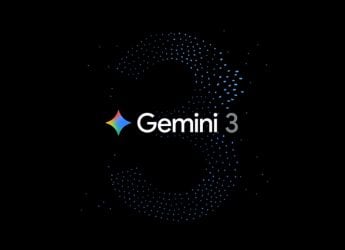Google Unveils Gemini 1.5, Meta Introduces Predictive Visual Machine Learning Model V-JEPA
Google says Gemini 1.5 will have a limited version with a context window of up to 1 million tokens.

Photo Credit: Google
Meta’s V-Jepa is a non-generative model that learns by predicting missing or masked parts of a video
Google and Meta made notable artificial intelligence (AI) announcements on Thursday, unveiling new models with significant advancements. The search giant unveiled Gemini 1.5, an updated AI model that comes with long-context understanding across different modalities. Meanwhile, Meta announced the release of its Video Joint Embedding Predictive Architecture (V-JEPA) model, a non-generative teaching method for advanced machine learning (ML) through visual media. Both products offer newer ways of exploring AI capabilities. Notably, OpenAI also introduced its first text-to-video generation model Sora on Thursday.
Google Gemini 1.5 model details
Demis Hassabis, CEO of Google DeepMind, announced the release of Gemini 1.5 via a blog post. The newer model is built on the Transformer and Mixture of Experts (MoE) architecture. While it is expected to have different versions, currently, only the Gemini 1.5 Pro model has been released for early testing. Hassabis said that the mid-size multimodal model can perform tasks at a similar level to Gemini 1.0 Ultra which is the company's largest generative model and is available as the Gemini Advanced subscription with Google One AI Premium plan.
The biggest improvement with Gemini 1.5 is its capability to process long-context information. The standard Pro version comes with a 1,28,000 token context window. In comparison, Gemini 1.0 had a context window of 32,000 tokens. Tokens can be understood as entire parts or subsections of words, images, videos, audio or code, which act as building blocks for processing information by a foundation model. “The bigger a model's context window, the more information it can take in and process in a given prompt — making its output more consistent, relevant and useful,” Hassabis explained.
Alongside the standard Pro version, Google is also releasing a special model with a context window of up to 1 million tokens. This is being offered to a limited group of developers and its enterprise clients in a private preview. While there is no dedicated platform for it, it can be tried out via Google's AI Studio, a cloud console tool for testing generative AI models, and Vertex AI. Google says this version can process one hour of video, 11 hours of audio, codebases with over 30,000 lines of code, or over 7,00,000 words in one go.
Meta V-JEPA details
In a post on X (formerly known as Twitter), Meta publicly released V-JEPA. It is not a generative AI model, but a teaching method that enables ML systems to understand and model the physical world by watching videos. The company called it an important step towards advanced machine intelligence (AMI), a vision of one of the three 'Godfathers of AI', Yann LeCun.
In essence, it is a predictive analysis model, that learns entirely from visual media. It can not only understand what's going on in a video but also predict what comes next. To train it, the company claims to have used a new masking technology, where parts of the video were masked in both time and space. This means that some frames in a video were entirely removed, while some other frames had blacked-out fragments, which forced the model to predict both the current frame as well as the next frame. As per the company, the model was able to do both efficiently. Notably, the model can predict and analyse videos of up to 10 seconds in length.
“For example, if the model needs to be able to distinguish between someone putting down a pen, picking up a pen, and pretending to put down a pen but not actually doing it, V-JEPA is quite good compared to previous methods for that high-grade action recognition task,” Meta said in a blog post.
At present, the V-JEPA model only uses visual data, which means the videos do not contain any audio input. Meta is now planning to incorporate audio alongside video in the ML model. Another goal for the company is to improve its capabilities in longer videos.
Get your daily dose of tech news, reviews, and insights, in under 80 characters on Gadgets 360 Turbo. Connect with fellow tech lovers on our Forum. Follow us on X, Facebook, WhatsApp, Threads and Google News for instant updates. Catch all the action on our YouTube channel.
Related Stories
- Samsung Galaxy Unpacked 2025
- ChatGPT
- Redmi Note 14 Pro+
- iPhone 16
- Apple Vision Pro
- Oneplus 12
- OnePlus Nord CE 3 Lite 5G
- iPhone 13
- Xiaomi 14 Pro
- Oppo Find N3
- Tecno Spark Go (2023)
- Realme V30
- Best Phones Under 25000
- Samsung Galaxy S24 Series
- Cryptocurrency
- iQoo 12
- Samsung Galaxy S24 Ultra
- Giottus
- Samsung Galaxy Z Flip 5
- Apple 'Scary Fast'
- Housefull 5
- GoPro Hero 12 Black Review
- Invincible Season 2
- JioGlass
- HD Ready TV
- Laptop Under 50000
- Smartwatch Under 10000
- Latest Mobile Phones
- Compare Phones
- Realme P4x 5G
- OnePlus Ace 6T
- Nubia Flip 3
- Nubia Fold
- OPPO A6x 5G
- Samsung Galaxy Z TriFold
- Poco F8 Ultra
- Poco F8 Pro
- Asus ProArt P16
- MacBook Pro 14-inch (M5, 2025)
- Poco Pad M1
- Poco Pad X1
- Just Corseca Skywatch Pro
- Honor Watch X5
- Acerpure Nitro Z Series 100-inch QLED TV
- Samsung 43 Inch LED Ultra HD (4K) Smart TV (UA43UE81AFULXL)
- Asus ROG Ally
- Nintendo Switch Lite
- Haier 1.6 Ton 5 Star Inverter Split AC (HSU19G-MZAID5BN-INV)
- Haier 1.6 Ton 5 Star Inverter Split AC (HSU19G-MZAIM5BN-INV)
















